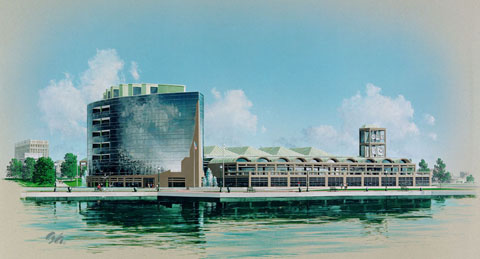EXECUTIVE SUMMARY
The Virginia Advanced Shipbuilding and Carrier Integration Center is the leading researcher in nuclear-powered aircraft carriers and obtains a well-deserved signature structure that is visible from the distance. The Technology Tower stands approximately 135 feet in the air. The VASCIC Facility is architecturally influenced by water, most importantly, the ship industry. The façade is mainly a curtain wall system with detailing of horizontal precast concrete bands.
This report is a final documentation of the facility primarily focusing on lighting and electrical redesign of four spaces located either in the Technology Tower of the Laboratory Wing. In addition to these two main depths of study, two other breadths of study outside of lighting and electrical design were performed to further enhance the design of the facility. These breadths include an architectural landscape design of an exterior space as well as an acoustical study performed in response to a ceiling material change in the auditorium space.
The lighting depth comprises a redesign of the lighting systems. Prior to finalizing designs, preliminary design concepts and criteria were compiled in order to properly design the lighting for each individual space. Furthermore, surface materials were accounted for when determining where and how to place light throughout the facility. Luminaire layouts, mounting details, performance summaries, and final renderings of each new design are included. The four spaces that were considered for these redesigns are the main lobby, the open office located on the fourth floor of the Technology Tower, the auditorium located on the second floor of the Laboratory Wing, and finally an exterior gathering space that was first designed architecturally.
In response to the lighting design changes, the electrical depth considers the lighting load changes on each panelboard. These changes directly affect the sizing of branch circuits, panelboards, feeders, and protective devices. In addition, voltage drop calculations, short circuit calculations, and a protective device coordination study were conducted to confirm equipment and feeders were properly sized. Furthermore, two electrical breadths were conducted. A motor control center was designed for the laboratory main electrical room to easily compile all the motors of the space in one location for maintenance purposes, as well as a cost analysis of busducts verses conduit and feeders for the Laboratory Wing.
This report is intended to demonstrate an integrative approach to building design process and analysis providing a more comprehensive understanding of the architectural engineering design process.
Note: White great efforts have been taken to provide accurate and complete information on the pages of CPEP, please be aware that the information contained herewith is considered a work-in-progress for this thesis project. Modifications and changes related to the original building designs and construction methodologies for this senior thesis project are solely the interpretation of Alyson Larimer. Changes and discrepancies in no way imply that the original design contained errors or was flawed. Different assumptions, code references, requirements, and methodologies have been incorporated into this thesis project; therefore, investigation results may vary from the original design.
